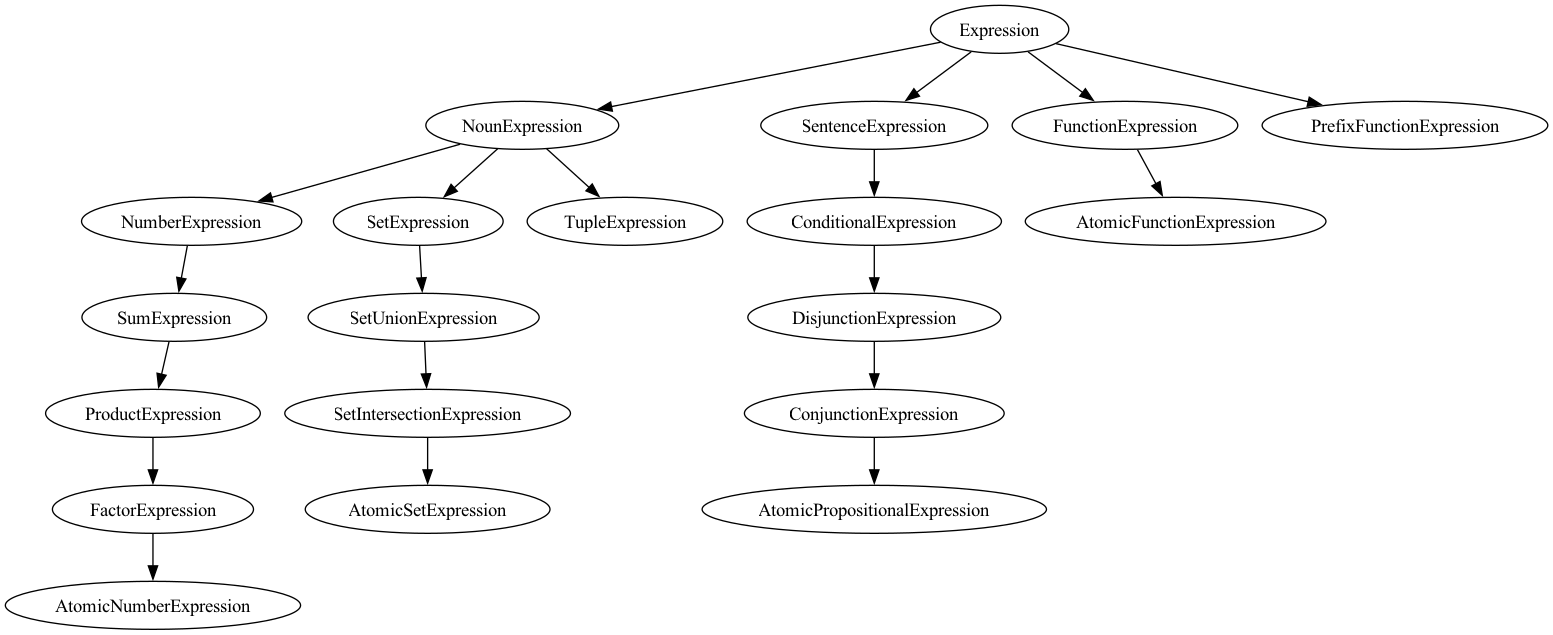This module stores a collection of hierarchies of syntactic types used in mathematical writing. We distinguish "syntactic types" from "semantic types" in the following way.
Mathematics notation tends to use certain precedences regardless of the
meaning of the symbols. For example, the LaTeX expression x+y\cdot z will
be read by a reader as a sum of x and the product of y and z, regardless of
whether those operations are standard addition and multiplication of numbers
or some other operations, such as string concatenation and repetition, or
matrices, or ordinary addition of a number with a dot product of vectors, or
anything else.
Therefore this repository factors out of the definition of any one parser the general notions of precedence that are used across mathematical notation, so that each parser does not need to redefine such precedences (as inclusions of types in one another) for itself. This makes the definition of each parser easier for the author, less error-prone, and more predicatable for the end user of that parser.
In the example above, sums and products are syntactic types, because we can speak of their relative precedence regardless of what "sum" or "product" means in any particular situation. A product can always be one of the summands in a sum, but sums cannot be any of the factors in a product, unless the writer of the expression puts some grouping symbol (such as parentheses) around them to change the default precedence. This has nothing to do with what adding or multiplying means, so we call them syntactic types.
Their hierarchy is shown in the following diagram, which was machine-generated from the data in this file.

A user of this repository can define notations by adding semantic types as
subtypes of the syntactic types. For example, the language author might say
that number_multiplication is a subtype of product and is written using
such-and-such notation. Then number_multiplication will be a semantic
type, while product always remains a syntactic type. The language author
does not need to specify the precedence of semantic types, because the
semantic types are situated within syntactic types, from which they get their
behavior. See the documentatin of the Converter class for
more explanation of semantic types.
See
Source
Members
hierarchies
This variable stores all the syntactic types recognized by this repository,
as a set of chains of parent-child relationships. That is, if it contains
[[A_1,...,A_n],[B_1,...,B_n],...] then A_1 is a parent type of A_2,
which is a parent type of A_3, and so on. Similarly, B_1 is a parent
type of B_2, which is a parent type of B_3, and so on, but there is no
assumed relationship between any A_i and B_j unless the same type appears
in both chains.
The topmost type in the hierarchy is Expression, and there should be no
types above it. The lowest types in the hierarchy must all begin with the
word atomic, as in AtomicPropositionalExpression or AtomicNumberExpression.
Source
isAtomic
This function embodies the convention mentioned in the documentation for the
hierarchies variable, which is that
atomic types must begin with the word atomic. This function just checks to
see if that prefix is present.
See
Source
isSupertype
Is the syntactic type a a proper supertype of the syntactic type b? This
function uses the data in the hierarchies variable to answer that question. Note that this function is
not reflexive, but the isSupertypeOrEqual() version is.
Source
isSupertypeOrEqual
Is the syntactic type a a supertype of the syntactic type b, whicn
includes the possibility that a and b may be equal? This function is the
same as the isSupertype() function,
except that it includes the possibility that a and b may be equal. That
is, this function is reflexive.
Source
lowestSubtype
A syntactic type has a lowest subtype if that syntactic type appears in exactly one of the chains in the hierarchies variable. If there is such a chain, this function returns the name of the lowest subtype in that chain (which is often atomic). If not, this function returns its input, so that the result is always a valid type name.
Source
types
A single JavaScript array containing all types mentioned in the syntactic types hierarchies defined in the hierarchies variable. Unlike the hierarchies variable, this array is flat, containing only strings, and containing each type exactly once. Its order does not matter; the order matters in the heirarchies variable, but not here.
One common use of this variable is to check whether a given identifier is the
name of a syntactic type, by checking .includes() with respect to this
array.